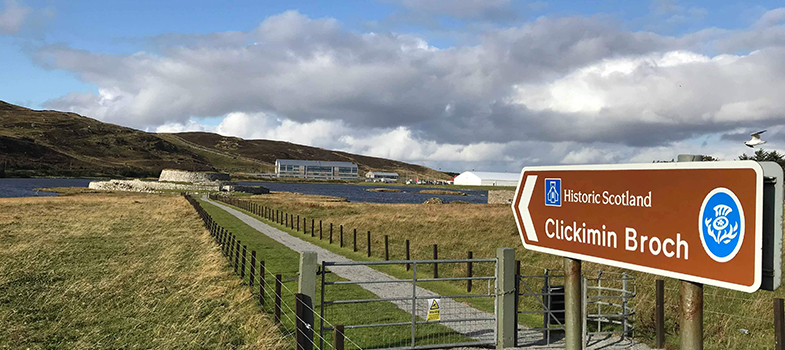14.5 Scots in fiction, legend and song
Fiction
Some people acquire their knowledge of history not through history books but through historical novels. It is sometimes said that Scotland was the birthplace of the historical novel owing to the success of Sir Walter Scott’s Waverley Novels [Tip: hold Ctrl and click a link to open it in a new tab. (Hide tip)] , written between 1814 and 1832. Since Scott’s time, many Scottish writers, such as James Hogg, John Galt, Robert Louis Stevenson, Neil Munro, John Buchan, Nigel Tranter and Dorothy Dunnett, have written novels set in the Scottish past, and many of them have used Scots, mainly in dialogue, to capture the atmosphere and events of the past.
In the following extract, taken from The Heart of Midlothian (1818) by Sir Walter Scott, the true event depicted took place in 1736. An officer of the City Guard, Captain John Porteous, was found guilty of ordering his soldiers to open fire on a crowd of citizens at a public hanging, and was himself sentenced to be hanged. However, at the last minute he was granted a reprieve by the Government. Many Scots saw this as unwanted interference in Scottish affairs by London. Scott uses the conversation of his fictional characters, disappointed not to have seen Porteous hang, to illustrate anti-Union discontent:
‘An unco thing this, Mrs Howden,’ said old Peter Plumdammas to his neighbour the rouping-wife, or saleswoman, as he offered her his arm to assist her in the toilsome ascent, ‘to see the grit folk at Lunnon set their face against law and gospel, and let loose sic a reprobate as Porteous upon a peacable town!’
‘And to think o’ the weary walk they hae gien us,’ answered Mrs Howden with a groan; ‘and sic a comfortable window as I had gotten, too, just within a penny-stane-cast of the scaffold – I could hae heard every word the minister said – and to pay twal pennies for my stand, and a’ for naething!’
‘I am judging,’ said Mr Plumdamas, ‘that this reprieve wadna stand gude in the auld Scots law, when the kingdom was a kingdom.’
‘I dinna ken muckle about the law,’ answered Mrs Howden; ‘but I ken, when we had a king, and a chancellor, and Parliament-men o’ our ain, we could aye peeble them wi’ stanes when they werena gude bairns – But naebody’s nails can reach the length o’ Lunnon.’
‘Weary on Lunnon, and a’ that e’er came out o’t!’ said Miss Grizel Damahoy, an ancient seamstress; ‘they hae taen awa our Parliament, and they hae oppressed our trade. Our gentles will hardly allow that a Scots needle can sew ruffles on a sark, or lace on an owerlay.’
In this passage, Scott cleverly outlines some of the grievances, both serious and petty, that many Scots felt in the decades immediately following the loss of national independence in 1707. Partly through humour and especially through a striking and lively use of Scots, he makes some serious points. The second speech of Mrs Howden, beginning ‘I dinna ken muckle about the law’, is now one of the quotations engraved on the outside wall of the Scottish Parliament building. Read it carefully and make a short analysis of what political point Scott is making through his fictional character.

Legend
You may already think that some of the historical events discussed in this section have a more ‘legendary’ than ‘factual’ feel to them. For example, the ‘mak sicker’ story (the murder of Comyn by Bruce), or the story of Jenny Geddes’s remarks are not supported by strong historical evidence, even though the events they are a part of undoubtedly took place. This is where history and popular legend become confused. Sometimes the legend is so much more powerful than what the historical record shows that it becomes almost impossible to challenge.
A good example of this is the phrase ‘Whaur’s yer Wullie Shakespeare noo?’ allegedly shouted by a member of the audience at the first performance of John Home’s play Douglas in Edinburgh in 1756. It is not clear whether the cry was deeply ironic or was made by an enthusiastic Scottish patriot, or if it was made at all.
![]()
Look up the word Whar in the Dictionary of the Scottish Language here and read the items specifically related to this phrase: ‘Whaur’s yer Wullie Shakespeare noo?’
- What does this tell you about the ability of a good story to generate further manifestations of itself?
- Do you think the legend, and others like it, would have been perpetuated if the sentence had been delivered in English rather than Scots?
Song
As you have studied in unit 12, many incidents in Scottish history have been celebrated or marked by songs written and performed in Scots. There are countless examples of this: battles, feuds, emigration, land clearance, crime, work of various kinds have all had songs in Scots written about them.
To take the theme of battles, ‘Scots Wha Hae’ by Robert Burns (1793) is about the Battle of Bannockburn in 1314; ‘The Flooers o’ the Forest’ by Jean Elliot (1756 or 1758) is a lament for the Battle of Flodden in 1513; ‘Hey Johnnie Cope’ by Adam Skirving records the Battle of Prestonpans in 1745; and Hamish Henderson’s ‘The 51st Highland Division’s Farewell to Sicily’ records part of the Italian campaign of the Second World War.
![]()
The words of Hamish Henderson’s song can be read at the Scottish Poetry Library’s website.
- What do these words tell you about the Italian campaign? With whom do the songwriter’s sympathies lie?
- Does the use of Scots give you any indication about the answers to these questions?
You may wish to think of a historical theme other than war, and research three or four songs written in Scots that illustrate that theme. Again, make notes about how the use of Scots helps to illuminate history or to memorialise historical events.
- Does the fact that the narration takes the form of a song sung in Scots help to make the story more memorable? If so, why?
14.4 Scots in oral history
